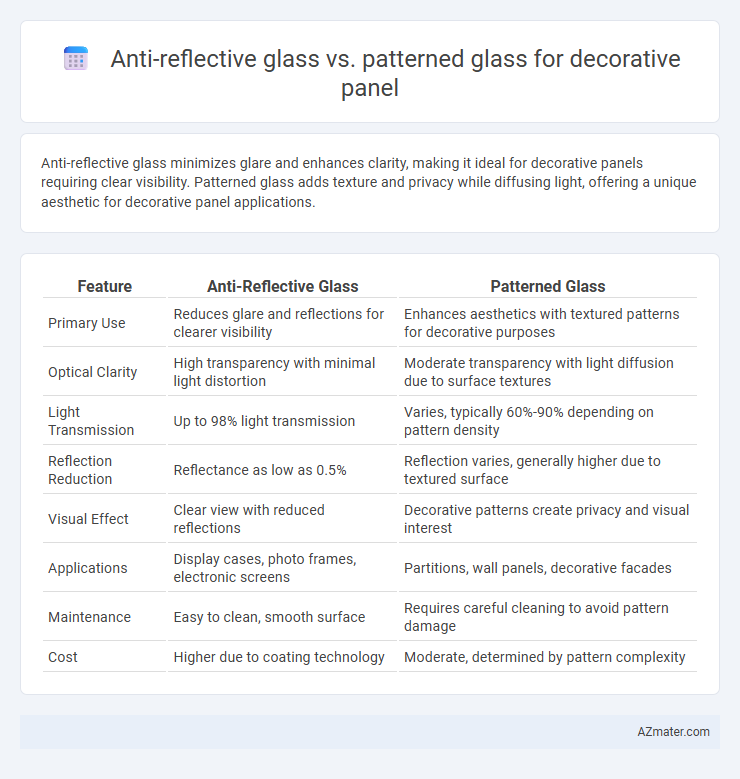Anti-reflective glass minimizes glare and enhances clarity, making it ideal for decorative panels requiring clear visibility. Patterned glass adds texture and privacy while diffusing light, offering a unique aesthetic for decorative panel applications.
Table of Comparison
| Feature | Anti-Reflective Glass | Patterned Glass |
|---|---|---|
| Primary Use | Reduces glare and reflections for clearer visibility | Enhances aesthetics with textured patterns for decorative purposes |
| Optical Clarity | High transparency with minimal light distortion | Moderate transparency with light diffusion due to surface textures |
| Light Transmission | Up to 98% light transmission | Varies, typically 60%-90% depending on pattern density |
| Reflection Reduction | Reflectance as low as 0.5% | Reflection varies, generally higher due to textured surface |
| Visual Effect | Clear view with reduced reflections | Decorative patterns create privacy and visual interest |
| Applications | Display cases, photo frames, electronic screens | Partitions, wall panels, decorative facades |
| Maintenance | Easy to clean, smooth surface | Requires careful cleaning to avoid pattern damage |
| Cost | Higher due to coating technology | Moderate, determined by pattern complexity |
Introduction to Decorative Glass Panels
Decorative glass panels enhance interior aesthetics by combining functionality with visual appeal, utilizing materials like anti-reflective and patterned glass for distinct effects. Anti-reflective glass minimizes glare and reflections, creating a clear, unobstructed view, ideal for modern, sleek designs. Patterned glass features textured or etched surfaces that add depth and privacy while diffusing light, making it suitable for artistic and intricate decorative applications.
What is Anti-Reflective Glass?
Anti-reflective glass features a special coating that reduces glare and reflections, enhancing clarity and visibility through the decorative panel. This type of glass is ideal for showcasing artwork or displays where visual detail and minimal light distraction are crucial. Compared to patterned glass, which offers texture and visual interest, anti-reflective glass prioritizes transparency and optical performance in decorative applications.
What is Patterned Glass?
Patterned glass features textured surfaces created by rolling molten glass over engraved metal rollers, resulting in unique designs that offer privacy while allowing light transmission. Unlike anti-reflective glass, which minimizes glare and enhances clarity through specialized coatings, patterned glass adds a decorative element by obscuring direct views and diffusing light. Its applications in decorative panels include partitions, cabinet doors, and shower enclosures where aesthetic appeal and functional privacy are essential.
Key Differences Between Anti-Reflective and Patterned Glass
Anti-reflective glass reduces glare and enhances transparency by minimizing light reflection, making it ideal for clear views in decorative panels. Patterned glass features textured or embossed surfaces that obscure visibility while adding design elements, providing both privacy and aesthetic appeal. The key difference lies in anti-reflective glass prioritizing clarity and light transmission, whereas patterned glass emphasizes visual texture and privacy.
Aesthetic Impact: Visual Effects and Styles
Anti-reflective glass enhances decorative panels by minimizing glare and reflections, creating a clear, crisp visual effect that highlights intricate designs with sharpness and vibrancy. Patterned glass introduces texture and depth through etched or embossed motifs, offering a tactile aesthetic that diffuses light and adds dimensionality to interiors. Both glass types significantly influence the panel's style; anti-reflective glass suits modern, sleek environments, while patterned glass complements classic or artistic decors with its ornamental charm.
Light Transmission and Clarity Comparisons
Anti-reflective glass offers superior light transmission, typically exceeding 98%, ensuring minimal glare and maximum clarity, which enhances the overall visibility and brilliance of decorative panels. Patterned glass reduces light transmission due to its textured surface, often allowing 70-85% of light through, creating diffused illumination and obscured visibility for privacy-focused applications. While anti-reflective glass prioritizes clarity and sharpness, patterned glass emphasizes decorative aesthetics and light diffusion, influencing the choice based on design and functional requirements.
Durability and Maintenance Considerations
Anti-reflective glass offers superior durability due to its resistant coating that minimizes scratches and reduces glare, making it ideal for long-lasting decorative panels. Patterned glass, while visually appealing with textured designs, may require more frequent cleaning to prevent dirt accumulation in grooves and can be more susceptible to damage from physical impact. Maintenance for anti-reflective glass is typically easier, needing only regular gentle cleaning, whereas patterned glass demands careful attention to preserve both its texture and aesthetic integrity.
Applications in Interior and Exterior Design
Anti-reflective glass enhances visibility and reduces glare, making it ideal for decorative panels in modern interior spaces such as offices, galleries, and retail environments where clarity and light transmission are crucial. Patterned glass offers textured surfaces that diffuse light and provide privacy, commonly used in exterior building facades, partitions, and bathroom enclosures to add aesthetic depth and concealment. Both materials cater to distinct design needs; anti-reflective glass emphasizes transparency and brightness, while patterned glass focuses on decorative texture and subtle light play.
Cost Analysis: Anti-Reflective vs Patterned Glass
Anti-reflective glass generally incurs higher upfront costs due to advanced coating technologies that reduce glare and improve clarity, making it suitable for premium decorative panels. Patterned glass often offers a more cost-effective alternative, with manufacturing processes centered on embossing or etching designs directly onto the glass surface, leading to lower production expenses. When evaluating overall value, consider maintenance and longevity factors where anti-reflective coatings may require periodic reapplication, whereas patterned glass maintains its decorative appeal without additional treatments.
Choosing the Best Glass for Decorative Panels
Anti-reflective glass enhances decorative panels by reducing glare and improving visibility, making colors and designs more vibrant and clear in various lighting conditions. Patterned glass adds texture and privacy while creating visual interest with etched or embossed designs, suitable for spaces requiring both decoration and discretion. Choosing the best glass for decorative panels depends on the desired aesthetic effect, light transmission, and functional needs such as glare reduction or privacy enhancement.

Infographic: Anti-reflective glass vs Patterned glass for Decorative panel
 azmater.com
azmater.com